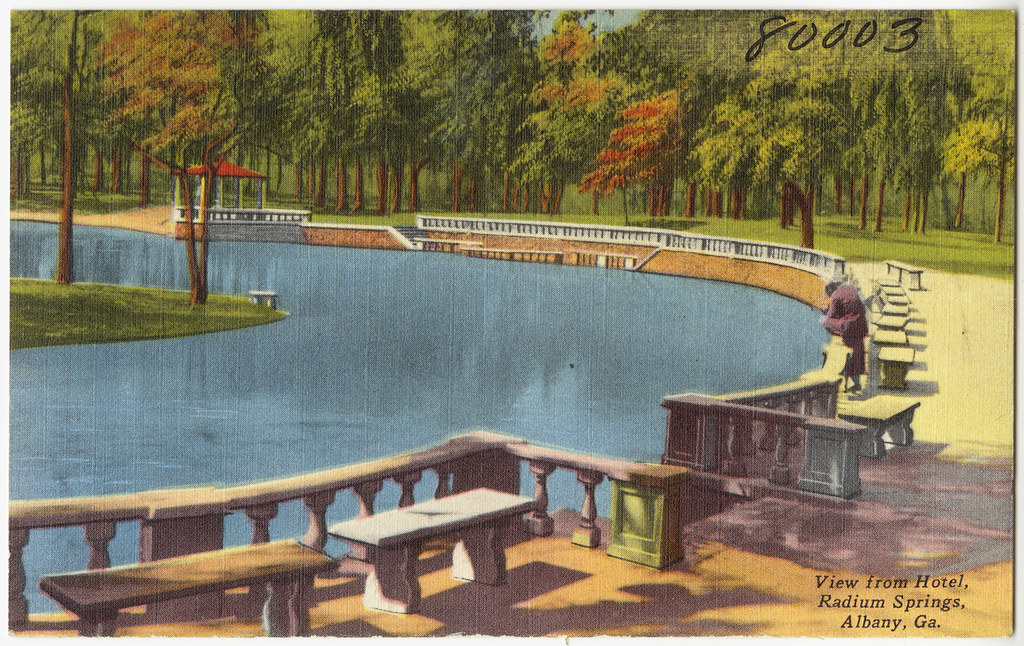I follow the various geo-blogs on an RSS reader like many of you do. Google’s LatLong Blog announced an imagery update on January 9 as it does periodically. So I checked the list of improvements as is my normal custom. One of the towns updated with high resolution aerial imagery sparked my curiosity: Radium Springs, New Mexico.
I’ve spent a lifetime avoiding radiation. So it seems odd to me that many people considered radiation beneficial and even healthy during the early parts of the 20th Century. Many bathed in naturally irradiated waters. Others breathed in radon gas. Some even exposed themselves to radium as a curative for all sorts of maladies. How times have changed!
My wife and I bought a house several years ago. Then we found we could not complete the purchase until it passed a radon gas inspection. The sellers had to install an abatement system to vent extremely low levels of radon gas as a condition of the sale. It may have been an attractive option a century ago, I suppose: “and the basement even comes with its own radon spa!” Not so much now.
Radiation Hormesis
The practice continues to attract followers in the form of “radiation hormesis.”
“Radiation hormesis proposes that radiation exposure comparable to and just above the natural background level of radiation is not harmful but beneficial, while accepting that much higher levels of radiation are hazardous… Consensus reports by the United States National Research Council and the National Council on Radiation Protection and Measurements and the United Nations Scientific Committee on the Effects of Atomic Radiation (UNSCEAR) argue that there is no evidence for hormesis in humans and in the case of the National Research Council, that hormesis is outright rejected as a possibility.”
There are spas today in Germany, Austria, Japan, the United States and elsewhere that follow this practice. Patrons can choose to bathe, breathe, bask in or imbibe radioactive materials. Apparently adherents believe that low-level exposure is quite effective for treating arthritis and other auto-immune diseases.
I’m not sure I would take the risk. But I’m not going to make a value judgment either. Thus, my only interest is finding towns that arose during a time a century ago when the general populace considered a little radiation a good thing.
Radium Springs, New Mexico

Let’s take a look at some of that new high resolution imagery for Radium Springs, NM, just up the road from Las Cruces. Certainly, Radium Springs has the aforementioned radium springs. It’s also the site of Fort Selden State Monument (pictured above) which I found considerably more interesting for a couple of reasons.
First, it was a base for the famed Buffalo Soldiers. Also in 1884, Captain Arthur MacArthur, Jr. became commander, bringing along his family including a young Douglas MacArthur.
Radium Springs, Georgia

This version of Radium Springs is located in Georgia, southeast of Albany (map). It is one of the largest natural springs in the state and has long been a resort. They used to call it “Blue Springs” until someone discovered radium in the water and changed the name. Next came a casino, a spa, a golf course and the other amenities.
Radium Hot Springs, British Columbia

Canadians deserve to be irradiated too, and that can be accommodated at Radium Hot Springs in British Columbia (map). As with the others, the name arose in the early 20th Century as a selling point for a resort and spa.
Others
I found a few other minor instances of Radium in the database of the U.S. Board on Geographic Names.
- Arizona (map)
- Kansas (map) – population 25.
- Minnesota (map) – now a ghost town
- Texas (map)
- Virginia (map)
I think most of those were probably named for uranium mining rather than spa experiences.
As I wrote this I kept thinking of Radiator Springs, the fictional town in the movie Cars. My kids watched that movie at least a hundred times so I’m pretty familiar with it. I’ve never actually seen the movie from end-to-end but I’ve probably watched it several times in ten-minute snippets (those of you who have ever had young children have likely experienced something similar). Radium Springs, NM seems to have a similar geographic setting. I wonder if they’re related?

Leave a Reply